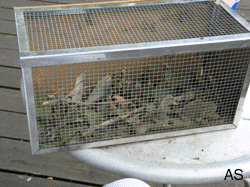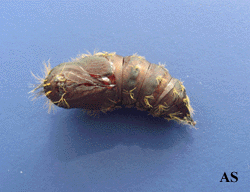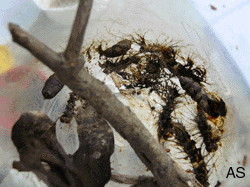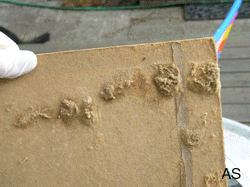
Gypsy Moth Experiments
This section describes some of the experiments we performed on Gypsy Moths during the spring of 2007. We had several cages equipped to house the caterpillers as-well-as the moths so that we could try to learn more about them and save our trees. We put sticks for them to climb on and a wet cotton ball for moisture. Leaves of various trees were added to see if there were some they didn't eat. Below are the results of our rather crude experiments:

Cage Used For Gypsy
Moth Experiments

Gypsy Moth Pupa

Caterpillar Sick of Virus

Nearby Healthy Caterpillars
Caught Virus and Died

Eggs Laid by Segregated
Females in Cage

Caterpillars and Red Pepper
Question: Some caterpillers and pupa are noticeably larger than others. Can you differentiate between male and female based on size?
Answer: We gathered 40 large pupa and put them into one cage. All large pupa hatched out female. We tried this several times and got the same results each time. This result was expected as we knew that females molt 6 times, whereas males molt only 5 times.
Question: In books we learned that a natural virus called "nucleopolyhedrosis" kills gypsy moths. They die on the trees in an inverted "v" shape. We observed that they seemed to be dissolving from the inside and eventually ended up grey, gooey elongated dead masses. How lethal is their own virus to the healthy ones? And, would putting one sick or almost dead one into a container with live caterpillers have any result on the healthy ones in the same container?
Answer: We put one sick one in with live caterpillers as-well-as pupa. The pupa didn't finish or hatch out and were full of grey goo indicating that this virus is highly contageous between them. Every caterpiller in each of those containers died. As a result of this experiment, from then on when we found the "v" caterpillers hanging dead on the trees, we left them there to possibly kill others crawling near it.
It is apparent that they are very succeptable to their own virus. A positive observation is that the virus didn't seem to bother anything else we could find. There were other types of caterpillers around, but none died in a "v" shape of goo on any of our trees.
Question: Would female moths segregated from males, still lay eggs?
Answer: Some females were in cages that male moths couldn't get into, although many continuosly tried. These females still layed egg masses. However these eggs may not have hatched in the spring. We will not know, as we destroyed these eggs when we cleaned out the cage.
Question: Was there anything we had on-hand, or could come up with, that would deter them from going up our trees in the first place?
Answers:
1. Garlic -- We smashed garlic cloves around a tree on the bark about 2 feet up from the bottom. It was thick and left chunks of garlic on the trunk that you could smell before you got to the tree.
While we had no problems with vampires last year, the gypsy moths seemed to actually like the garlic
2. Cedar Mulch -- We spread cedar mulch around an Oak tree. They went right across
it and up the tree.
This actually attracts
them to the tree. We found we had a cedar tree in the woods on our property that the caterpillers had discovered before us.
3. Hot peppers -- Fresh Chili peppers were chopped and made into a circle on a table. We put several caterpillers inside to see if they would cross the barrier. This gave us a very unexpected result. Most just crossed the barrier as if they hadn't noticed the peppers. One large caterpiller, however, stopped to eat the peppers. It lingered and was standing on part of a pepper. It became violently ill and swelled up, including its feet. It turned a dark pink color and looked dead. After writhing around, it collapsed feet up. Poking it with something yielded no life. At first we suspected that the hot peppers did kill some of them. However, after about an hour, the "dead" caterpiller regained its composure and crawled away from the peppers as if nothing had happened. As for the others, they simply crawled over and ignored the hot peppers with no ill effects.
Eggs on Vehicle Wheels Experiment
To see about the Eggs on Vehicle Wheels Experiment follow this
Link:
Eggs on Vehicle Wheels